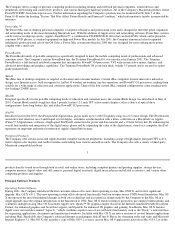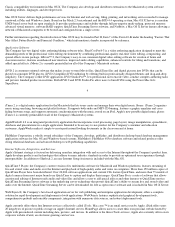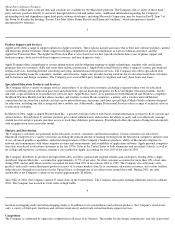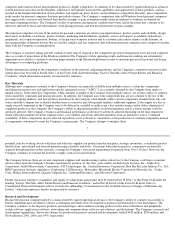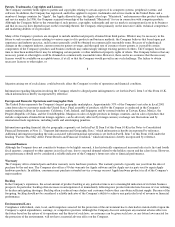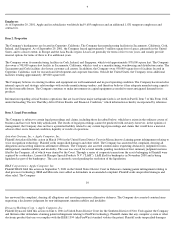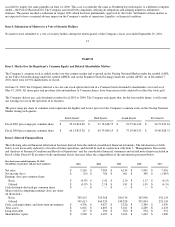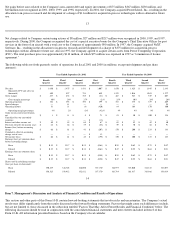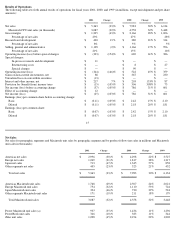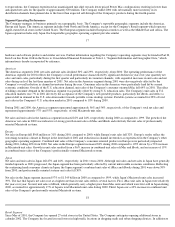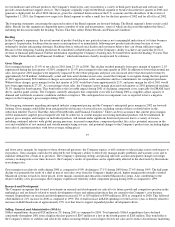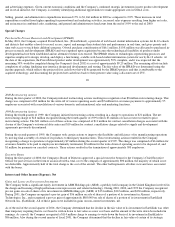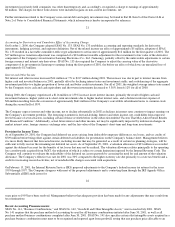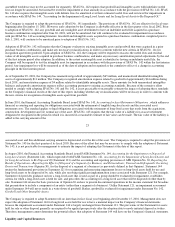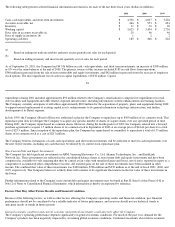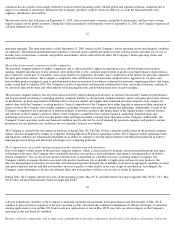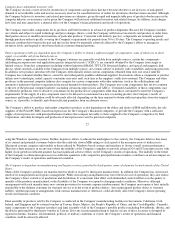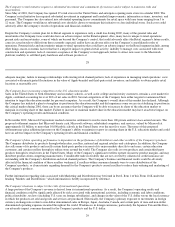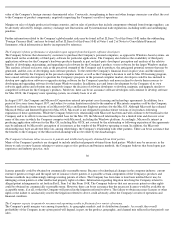Apple 2001 Annual Report Download - page 14
Download and view the complete annual report
Please find page 14 of the 2001 Apple annual report below. You can navigate through the pages in the report by either clicking on the pages listed below, or by using the keyword search tool below to find specific information within the annual report.
(a) Unit sales figures for Power Macintosh include sales of the Power Macintosh G4 Cube.
Net sales decreased $2.6 billion or 33% during 2001 compared to 2000, while Macintosh unit sales fell 32% from 2000. Demand for all of the
Company's products in all of the Company's geographic operating segments was negatively impacted throughout 2001 by unfavorable global
economic conditions. On a year-over-year basis, net sales and Macintosh unit sales were down in all of the Company's geographic operating
segments, and net sales and unit sales by product were down for each Macintosh product category except iBook. In addition to general
economic conditions, two other primary factors contributed to the decline in net sales during 2001. First, as discussed below, the Company
executed a plan during the first three quarters of 2001 to reduce substantially the level of inventory in its distribution channels. As a result of
these efforts, the Company's Macintosh channel inventory fell by approximately 450,000 units during the first nine months of 2001. Second,
the Company believes that many of its professional users are delaying upgrades of their Power Macintosh systems due to the Company's
ongoing transition to Mac OS X, its new operating system, and in anticipation of software vendors transitioning their Mac applications to run
natively in Mac OS X.
Several positive factors combined to partially mitigate the overall decline in net sales during 2001.The average revenue per Macintosh system,
a function of total net sales generated by hardware shipments and total Macintosh CPU unit sales, was relatively flat during 2001 at $1,695
compared to $1,715 in 2000. The flat revenue per Macintosh system reflects somewhat lower pricing year-over-year on comparative systems,
offset by a shift in overall sales mix towards higher-priced portable systems. Also, the Company experienced very little shift in the mix of
overall combined unit sales of relatively lower-priced consumer and education Macintosh systems, iMac and iBook, and their higher-priced
professionally oriented equivalents. Combined unit sales of iMac and iBook systems accounted for 58% of total Macintosh unit sales in 2001
and 60% in 2000. Second, combined unit sales of portable systems, iBook and PowerBook, actually rose 2% during 2001 despite the negative
economic climate and the overall decline in unit sales. Not only does this increase in portable sales reflect a general industry shift towards
portable systems, it is
16
also specifically attributable to the strong demand for redesigned iBooks introduced during the third quarter of 2001 and for the Titanium
PowerBook G4 which was introduced during the second quarter of 2001. Third, U.S. education unit sales rose 7% during 2001 compared to
2000 reflecting the Company's renewed focus on this core market within its America's operating segment.
First quarter 2001 net sales decreased 57% to $1.007 billion compared to the same quarter in 2000 and decreased 46% from the fourth quarter
of 2000. Both the year-over-year and sequential declines in net sales during the first quarter of 2001 were attributable to several factors,
including continued deterioration in worldwide demand for personal computers and rebate programs and price cuts instituted by the Company
during the quarter that cost the Company approximately $138 million. In addition, the Company implemented a plan during the first quarter to
reduce substantially the level of inventory in its distribution channels from the amounts at the end of fiscal 2000 to lower levels by the end of
the first quarter of 2001. The Company ended fiscal 2000 with substantially more inventory in its distribution channels than planned due to the
lower than expected sell-through of the Company's products during the fourth quarter of that year. The Company reduced channel inventory
during the first quarter by approximately 300,000 units. These factors contributed to the 52% year-over-year decline during the first quarter in
total Macintosh unit sales that were experienced across the Company's entire product line. These factors also reduced the average revenue per
Macintosh unit shipped (a function of total net sales generated by hardware shipments and total Macintosh CPU unit sales) during the first
quarter of 2001 to $1,476, a decline of approximately 12% from the same period in 2000.
Net sales rose 30% to a total of $7.983 billion in 2000 as compared to 1999. The increase in net sales resulted directly from a 32% increase in
Macintosh unit sales. Driving unit sales growth was a 51% increase in combined unit sales of the Company's consumer and education
Macintosh systems, iMac and iBook, and a modest increase of 11% in combined units sales of the Company's professionally oriented
Macintosh systems. Combined unit sales of iMac and iBook systems accounted for 52% of total Macintosh unit sales in 1999 and 60% in 2000.
During 2000, the average revenue per Macintosh system, a function of total net sales generated by hardware shipments and total Macintosh
CPU unit sales, was relatively flat at $1,715 compared to 1999. This was due to increased unit sales of higher priced Power Mac, PowerBook,
iBook, and G4 Cube systems offset by increases in unit sales of lower priced iMac systems.
Despite overall increases during 2000 in net sales, unit sales, and profitability, the Company's performance in the fourth quarter of fiscal 2000
was disappointing. Net sales during the fourth quarter fell short of the Company's expectations by approximately $180 million causing
operating margin before special charges to fall to 4% for the quarter as compared to the 9% experienced during the first nine months of fiscal
2000. The fourth quarter revenue shortfall was primarily the result of three factors. First, fourth quarter net sales of the G4 Cube, a new
Macintosh system announced and introduced by the Company during the fourth quarter, did not meet the Company's expectations. In
combination with related displays, G4 Cube sales were approximately $90 million short of expectations. Second, net sales in the Company's
education market fell short of expectations by approximately $60 million. Third, although total fourth quarter Power Mac unit sales were close
iBook unit sales
596
9
%
545
—
6
Total Macintosh unit sales
3,087
(32
)%
4,558
32
%
3,448


